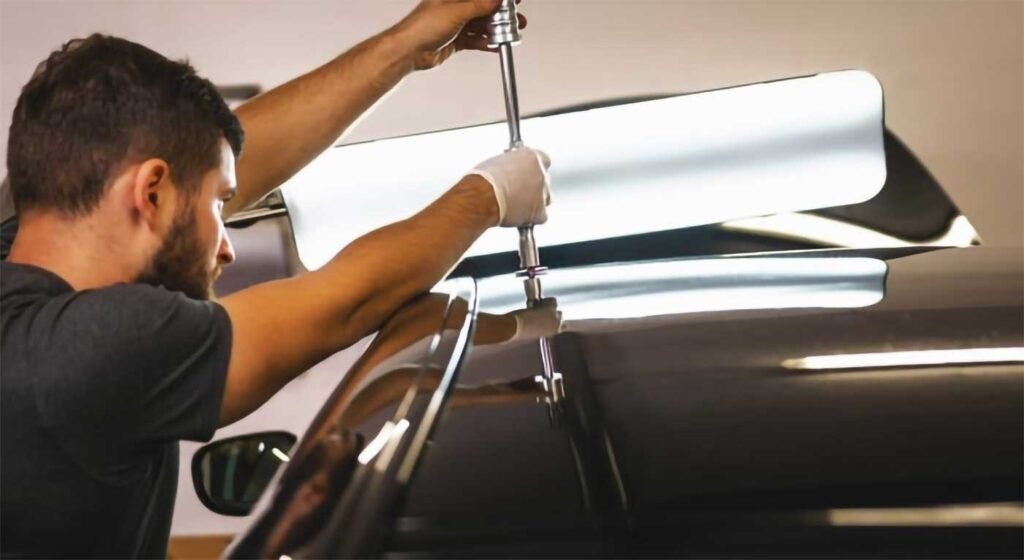Paintless Dent Repair (PDR) is a highly skilled technique that relies on specialized tools, techniques, and most importantly, PDR lighting. Proper lighting is essential for identifying dents, evaluating their depth, and ensuring flawless repairs. Without the right PDR lights, technicians may struggle to detect subtle imperfections, leading to poor-quality repairs.
In this guide, we will explore the importance of PDR lighting, the different types of lights used, how to choose the right lighting setup, and best practices for optimal results.
In this guide, we’ll explore why PDR is a superior alternative to repainting, its advantages, costs, process, and how it impacts your car’s value.
Why is PDR Lighting Important?
Effective PDR lighting is crucial for achieving high-quality dent repairs. Here’s why:
1. Enhanced Visibility of Dents
PDR lighting creates reflections and shadows that help technicians clearly see dents and their contours. Without proper lighting, small dents can go unnoticed, leading to incomplete repairs.
2. Precision in Dent Removal
Properly positioned lights help technicians gauge the depth and shape of the dent, ensuring accurate tool movements for a seamless repair.
3. Increased Efficiency
Using the right lighting reduces the time required to detect and repair dents, improving overall workflow and productivity.
4. Minimizes Errors
Poor lighting conditions can result in overcorrection or undercorrection of dents, requiring additional work. High-quality PDR lights minimize mistakes and ensure a flawless finish.
Types of PDR Lighting
1. LED PDR Lights
LED lights are the most commonly used in PDR because they offer bright, energy-efficient, and long-lasting illumination.
Advantages:
- Provides consistent brightness.
- Energy-efficient with low heat output.
- Available in multiple color temperatures for different working conditions.
Best for: Professional PDR technicians who need high accuracy and durability.
2. Fluorescent PDR Lights
Fluorescent lights were widely used before LEDs became the standard. They create soft lighting that helps in detecting shallow dents.
Advantages:
- Produces softer, more diffused light.
- Ideal for beginners learning dent detection techniques.
Best for: Learning environments and budget-conscious technicians.
3. Cordless PDR Lights
Cordless lights offer flexibility and portability, making them ideal for mobile PDR technicians.
Advantages:
- Easy to carry for on-the-go repairs.
- No need for power outlets.
- Rechargeable batteries for long-lasting performance.
Best for: Mobile dent repair services and on-site repairs.
4. Adjustable PDR Lights
These lights allow technicians to change brightness levels and angles for better visibility.
Advantages:
- Customizable lighting for various dent sizes and shapes.
- Reduces eye strain by adjusting brightness levels.
Best for: Professionals who work on different vehicle surfaces and require precision.
How to Choose the Best PDR Lighting
When selecting PDR lighting, consider the following factors:
1. Brightness & Light Intensity
Choose a light with adjustable brightness to adapt to different dent sizes and environmental conditions.
2. Color Temperature
Cool White (5000K – 6500K): Best for detecting fine details and smaller dents.
Warm White (2700K – 3500K): Works well in low-light environments and reduces eye strain.
Adjustable Color Temperature: Ideal for versatile use.
3. Power Source (Corded vs. Cordless)
Corded PDR lights provide continuous power but require an outlet.
Cordless models offer flexibility and mobility.
4. Light Panel Size
Smaller panels (12-24 inches): Best for spot repairs and door dings.
Larger panels (24-48 inches): Ideal for larger dents and full panels.
5. Portability & Mounting Options
Tripod-mounted lights: Great for stationary repair shops.
Magnetic or suction cup mounts: Perfect for on-the-go PDR technicians.
Best Practices for Using PDR Lighting
1. Positioning the Light Correctly
Place the light at an angle to highlight the dent’s edges.
Adjust the distance based on dent size – closer for small dents, farther for larger areas.
Use multiple light sources for better depth perception.
2. Adjusting Light Intensity
Use higher brightness for deeper dents.
Lower brightness helps in detecting surface imperfections.
3. Using Reflection Patterns
Straight-line reflections help in identifying depth and curvature.
Curved reflections reveal creases and sharp dents.
4. Working in a Controlled Environment
Avoid direct sunlight, which can distort reflections.
Use a dark background to enhance light contrast.
Top PDR Lighting Brands & Products
PDR vs. Traditional Dent R
1. Elim A Dent PDR Lights
Offers high-quality LED lights with adjustable brightness.
Popular among professional technicians.
2. Pro PDR Solutions Lights
Provides cordless and portable options.
Includes customizable reflection panels.
3. Carbon Tech PDR Lighting
Features lightweight, durable designs.
Comes with magnetic mounting options.
4. A1 Tools PDR Lights
Affordable yet high-performance PDR lighting solutions.
Available in various sizes and power options.
Common Mistakes to Avoid with PDR Lighting
1. Using the Wrong Light Color
Too bright or too dim light can make dent detection difficult.
Use adjustable color temperature for better accuracy.
2. Poor Light Placement
Placing the light too close or too far can distort reflections.
3. Ignoring Surrounding Light Conditions
Bright ambient lighting can reduce effectiveness.
Work in a controlled, low-light environment.
4. Not Using Multiple Angles
Checking dents from different perspectives ensures better accuracy.
Conclusion: Why PDR is the Better Choice
The success of Paintless Dent Repair heavily depends on the right PDR lighting setup. Whether you’re a professional technician or a beginner, investing in high-quality PDR lights improves precision, reduces errors, and enhances repair efficiency.
At TDB Automotive Service, we provide the best service to our customers.



